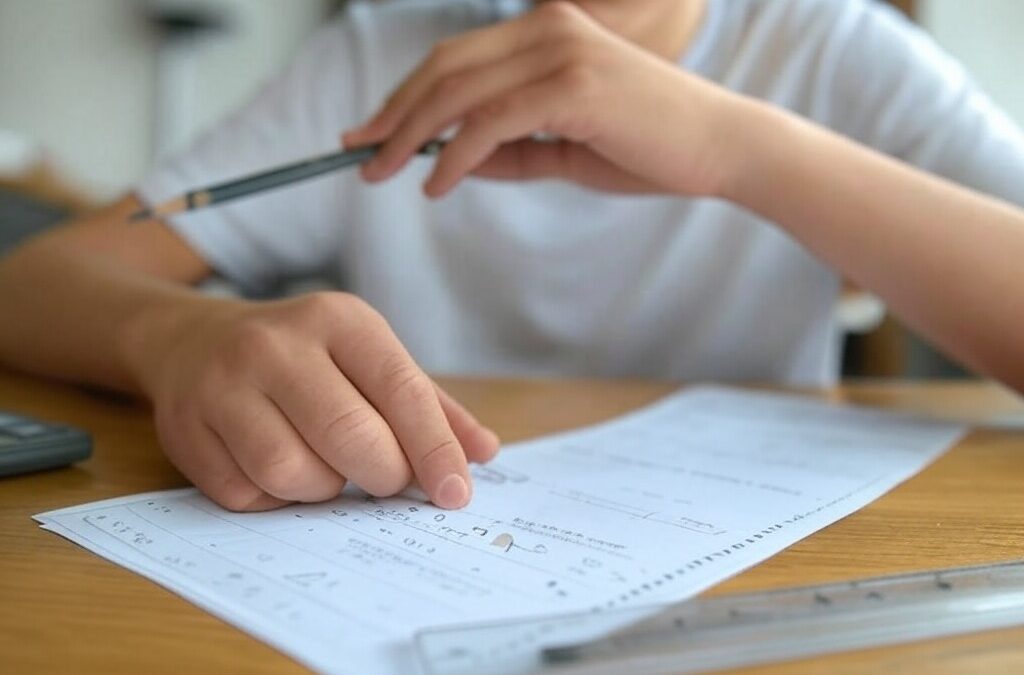
by TutorUp | Oct 14, 2024 | Education Topics
The high school dropout rate is decreasing, which is a good thing, but we still have 6% of students dropping out before graduation. Many students feel that if they’re not planning to go on to college, they don’t really need to finish high school. If you need some help emphasizing the importance of finishing high school to your student, here are some reasons for them to stick it out:
1. Life Skills: The Ultimate Survival Kit
High school isn’t just about algebra and dissecting frogs (which, let’s be honest, might come in handy if you’re ever stranded on a planet where frogs rule). It’s about learning how to think critically, solve problems, and communicate effectively. These skills are like the universal translator of life; they work everywhere, from the boardroom to the backroom of a spaceship.
2. Career Opportunities: Not Just for Rocket Scientists
Even if your kid dreams of becoming the best burger flipper in the galaxy or a master plumber, many jobs require or at least prefer a high school diploma. It’s like having a basic access code to a wider universe of job opportunities. Plus, who knows? Maybe they’ll discover a passion for something that requires further education.
3. Financial Literacy: The Currency of the Cosmos
High school often teaches you how to manage money, which is like learning how to navigate through the asteroid belt of financial pitfalls. Understanding taxes, budgeting, and basic economics can save your kid from becoming a space pirate out of necessity.
4. Social Skills and Networking: The Human Connection
School is where you learn to deal with all sorts of life forms, from the quiet bookworm to the loud, sports-obsessed comet. These social skills are invaluable, not just for jobs but for life. Plus, the friends they make might just be the crew for their future starship.
5. A Foundation for Any Path
Whether they decide to go into trades, start a business, or become an intergalactic artist, high school provides a foundation. It’s like having a basic toolkit; you might not use every tool, but having them means you’re prepared for almost anything.
6. The Discipline of Completion
Finishing high school teaches discipline, the kind that says, “I can stick with something even if it’s not my favorite planet in the solar system.” This discipline is crucial for any endeavor, from learning a trade to mastering the art of intergalactic travel.
7. The Unexpected Journey
Life has a way of throwing curveballs, or in space terms, unexpected meteor showers. A high school education can be the difference between being prepared for these surprises or getting knocked off course.
While the path to college isn’t for everyone, the path through high school is like the yellow brick road of life skills, opportunities, and personal growth. Encourage your kids to finish this journey not because it’s the only way, but because it’s a well-equipped spaceship for whatever adventure they choose next. Remember, in the grand scheme of the universe, a high school diploma might just be the key to unlocking their potential, whether they’re headed to the stars or staying right here on Earth.

by TutorUp | Sep 10, 2024 | Parent and Tutor Resources
Homework time can be a battlefield, but with a bit of strategy, you can turn this daily skirmish into a productive, even enjoyable, part of your routine. Here’s how you can help your kids not just survive, but thrive with homework:
1. Set Up a Homework Station
First things first, create a space that says “I mean business.” This doesn’t have to be a grand setup; a quiet corner with good lighting, all necessary supplies, and minimal distractions will do. Make it a place where they want to work, not escape from.
2. Establish a Routine
Kids thrive on routine. Set a regular homework time. Whether it’s right after school or after dinner, consistency helps. This isn’t just about when they do homework, but how long. Set a timer if you need to, but keep it flexible for those “I’m on a roll” moments.
3. Be the Guide, Not the Doer
Your role is to guide, not to do the homework for them. Help them understand concepts, but let them apply it. Remember, it’s their learning, not yours. Plus, teachers can spot parent-done homework from a mile away!
4. Break It Down
Homework can seem like Mount Everest. Break it into base camps. Tackle one subject at a time, or divide big projects into smaller, manageable tasks. This makes the process less daunting and more achievable.
5. Use Technology Wisely
Tech can be a tool or a trap. Educational apps, online resources, and even YouTube tutorials can be goldmines for learning. But, set boundaries. No social media or gaming during homework time unless it’s for research (and we all know how that goes).
6. Teach Time Management
Show them how to prioritize. Start with the toughest subjects first when their mind is fresh. Use planners or digital calendars to track assignments. This isn’t just about homework; it’s a life skill.
7. Encourage Breaks
The Pomodoro Technique (25 minutes of work, 5-minute break) can be magical. It keeps the brain from burning out. Encourage them to stand up, stretch, or even do a quick dance. Movement boosts brain function.
8. Positive Reinforcement
Celebrate small victories. Did they finish their math without a meltdown? Praise that! Positive reinforcement can turn homework from a chore into a series of mini-triumphs.
9. Be Patient and Understanding
Some days will be harder than others. If they’re struggling, be there to listen. Sometimes, the problem isn’t the homework but something else. Being a supportive listener can make all the difference.
10. Review and Reflect
At the end of the week, review what worked and what didn’t. Did they finish homework on time? Were there any subjects they found particularly tough? Reflection helps in refining your approach.
11. Get Help When Needed
If homework consistently becomes a battleground, it might be time to seek external help. Tutors, homework clubs, or even talking to the teacher can provide new insights or strategies.
Remember, homework isn’t just about academic learning; it’s about teaching responsibility, time management, and problem-solving. By setting up the right environment and approach, you’re not just helping with homework; you’re equipping your kids with skills for life.

by TutorUp | Aug 19, 2024 | Online Tutoring
As the scent of freshly sharpened pencils fills the air, and the excitement (or dread) of “back to school” season hits, let’s talk about a secret weapon that can make this school year not just good, but *great* for your kids. I’m not talking about the latest in lunchbox tech or the coolest backpack trends, but something far more powerful: tutoring.
1. The Confidence Kickstart:
Imagine your kid walking into class, not with the usual first-day jitters, but with a swagger. Tutoring can ensure they’re not just caught up but ahead of the game. When they’ve already got a handle on what’s coming, their confidence soars. And confidence, my friends, is half the battle in school.
2. Personalized Learning – Because One Size Does Not Fit All:
In a classroom of 20 or more, teachers do their best, but let’s face it, your child’s learning style might be as unique as their fingerprint. Tutoring offers a bespoke educational experience. It’s like tailoring a suit; it fits perfectly because it’s made just for them.
3. Bridging the Summer Slide:
Ah, the summer slide, where all those hard-earned academic gains from last year take a vacation. Tutoring can be the bridge that keeps your child’s brain from turning into a mushy, sunbaked mess. A few sessions to review and refresh can make all the difference.
4. Homework Help That Actually Helps:
Let’s be real, homework can be a battleground. With a tutor, it becomes a training ground. They can explain those tricky concepts, help with organization, and make homework time less of a war zone and more of a learning zone.
5. Setting Goals and Achieving Them:
Tutors are like personal trainers for the mind. They help set realistic academic goals and then work towards them. This isn’t just about getting good grades; it’s about teaching your child how to aim high and succeed, a life skill if there ever was one.
6. The Social Aspect:
Tutoring isn’t just about academics. It’s also about social skills. Learning to interact with a tutor can improve communication, discipline, and even resilience. Plus, if they’re in a group setting, it’s a chance to make new friends who share their academic interests.
7. Early Intervention:
Sometimes, the first few weeks of school can reveal gaps in understanding. Tutoring can catch these early, preventing a small gap from becoming a chasm. It’s like having a personal academic GPS, rerouting before they get lost.
So, as you gear up for the “back to school” rush, consider adding tutoring to your arsenal. It’s not just about catching up; it’s about setting your child up for success in ways that go beyond the classroom. Whether it’s for a boost in confidence, personalized learning, or just to make homework a bit less of a headache, tutoring could be the key to unlocking your child’s potential this school year.

by TutorUp | Jul 15, 2024 | Online Tutoring
As summer rolls around, it’s easy to picture your kids kicking back, enjoying some well-deserved time away from the classroom. But here’s something that might catch your attention: while summer is a break from school, it’s also a time when a lot of what they’ve learned can slip away. Research shows that students can lose up to two months’ worth of reading and math skills over the summer if they don’t stay engaged. That’s not just a small hiccup—it’s a gap that teachers often spend four to six weeks reteaching when the new school year starts. For parents like you, who want your child to head into the next grade ready to tackle what’s ahead, summer tutoring might be the game-changer you’re looking for.
Let’s talk about that loss for a moment. Studies, like those from the National Summer Learning Association, back this up: about 30% of the progress kids make during the school year can vanish over those warm, unstructured months. It’s often called the “summer slide,” and it’s especially tough on students who are already playing catch-up. Maybe your child struggled with fractions last year, or perhaps reading still feels like a mountain to climb. Without some reinforcement, those weak spots don’t just stay weak—they can get worse. Summer tutoring steps in here, offering a way to not only hold onto what they’ve learned but also close those gaps before they widen.
What’s great about summer tutoring is how it can be tailored to your child’s needs. Unlike the school year, where teachers are juggling a whole classroom, a tutor can zoom in on exactly what your kid needs help with. Data from the Annenberg Institute at Brown University shows that high-impact tutoring—think frequent, focused sessions—can help students gain back half a year to a full year of learning in subjects like math and reading. That’s huge, especially if your child fell behind during a rocky school year or just needs a boost to feel confident walking into the next one. Imagine your third-grader finally nailing those multiplication tables or your middle schooler smoothing out their essay-writing skills—all before the first bell rings in the fall.
The flexibility of summer also makes this doable for busy families. With no homework or after-school activities crowding the schedule, you can fit tutoring around camps or vacations. And here’s a stat that might surprise you: a 2020 review of nearly 100 tutoring programs found that intensive tutoring was particularly effective for younger kids in reading and for slightly older ones in math. So whether your child is seven or twelve, there’s evidence this can work. It’s not about cramming their summer with busywork—it’s about targeted support that sets them up to start the year strong.
Think about September for a second. Kids who’ve had some summer tutoring don’t just show up refreshed—they show up prepared. They’re not the ones scrambling to remember what a decimal is or how to sound out tricky words while the teacher moves on to new material. Instead, they’re ready to build on what they already know. Research from the U.S. Department of Education highlights that students who get this kind of support are better positioned to keep pace as the year progresses, especially if they’ve had a tough time before. For you, that means less stress watching them struggle and more pride seeing them thrive.
If your child’s had a bumpy road with school—or even if they’re doing okay but could use a little edge—summer tutoring could be the bridge to a smoother next year. It’s an investment in keeping their skills sharp and giving them a head start. By the time fall hits, you might just find they’re not only caught up but actually excited to take on what’s next. And as a parent, isn’t that the kind of confidence you want them to carry into the classroom?

by TutorUp | Jun 10, 2024 | Education Topics, Online Tutoring
In recent years, a troubling trend has emerged in education: student math scores on standardized tests are dropping. From national assessments like the NAEP to international benchmarks like TIMSS, the data paints a clear picture of decline, raising alarms among educators, parents, and policymakers. But there’s hope on the horizon. Online math tutoring is emerging as a powerful tool to not only help students catch up but also push them beyond grade-level expectations. Let’s dive into the numbers, explore why this is happening, and see how personalized online tutoring could be the game-changer we need.
The Sobering Stats: A Decade of Decline
The evidence is stark. The National Assessment of Educational Progress (NAEP), often dubbed “The Nation’s Report Card,” has tracked a significant slide in math performance over the past decade. For fourth graders, average scores dropped from 223 in 2015 to 217 in 2022, with a further dip to 215 reported in 2024. Eighth graders fared worse, falling from 265 in 2015 to 260 in 2022, and down to 258 in 2024. That’s an 8-point drop for eighth graders in just under a decade—a decline experts call “historic” and “troubling.” Internationally, the Trends in International Mathematics and Science Study (TIMSS) echoes this, showing U.S. fourth graders losing 18 points and eighth graders dropping 27 points between 2019 and 2023.
The pandemic certainly played a role, with the steepest declines between 2019 and 2022 coinciding with school closures and disrupted learning. Yet, the downward trend predates COVID-19. Scores were already stagnating or slipping by the mid-2010s, suggesting deeper, systemic issues. Lower-performing students have been hit hardest, with the bottom 10% of eighth graders losing 19 points on TIMSS since 2019, widening gaps between high and low achievers. Today, nearly one in five U.S. eighth graders lack even basic math proficiency, a sobering reality with long-term implications.
Why Are Scores Dropping?
So, what’s behind this slide? The pandemic’s impact—lost instructional time, remote learning challenges, and disrupted routines—explains part of it, but not all. Experts point to a pre-existing stagnation in math education, possibly tied to curriculum shifts in the mid-2010s, like the Common Core, which some argue moved too fast past fundamentals. Others highlight a growing disconnect: students increasingly report math feels irrelevant to their lives, sapping motivation. Add in test anxiety, stretched-thin teachers, and a reliance on rote learning over conceptual understanding, and you’ve got a perfect storm eroding math skills.
The data also reveals inequities. Low-income students and students of color, already underserved, saw steeper drops post-pandemic. For instance, NAEP’s 2022 results showed Latino and low-income eighth graders slipping below basic proficiency, a level they’d surpassed in 2019. This isn’t just a math problem—it’s an opportunity problem, threatening future success in a world demanding ever-higher skills.
Online Math Tutoring: A Lifeline for Recovery
Here’s the good news: we’re not powerless against this decline. Online math tutoring offers a tailored, accessible solution to bring students back to grade level—and beyond. Unlike traditional classroom settings, where one teacher juggles 20–30 students, online tutoring delivers one-on-one attention, targeting each student’s unique gaps and strengths. Research backs this up: a 2020 study from the Annenberg Institute found high-dosage tutoring (30+ minutes, three times a week) can accelerate learning by three to 15 months. For math, where discrete skills build on each other, this personalized approach is gold.
Imagine a fifth grader struggling with fractions. In a crowded classroom, they might fall further behind as the teacher moves on. With an online tutor, they get focused practice—say, breaking down improper fractions with visuals like pizza slices—until it clicks. The tutor can then push them ahead, introducing decimals or ratios early, exceeding grade-level norms. Platforms like Khan Academy, Wyzant, or local programs connect students with skilled tutors who adapt lessons in real time, often at a fraction of the cost of in-person help. Since the pandemic, these services have boomed, with over half of U.S. districts using relief funds for tutoring, per the Education Department.
Beyond skill-building, online tutoring tackles the intangibles dragging scores down. It boosts confidence—crucial when 31% of teens now “never” or “hardly ever” read for fun, per NAEP’s 2022 survey, hinting at broader disengagement. Tutors teach test-taking strategies (time management, educated guessing) that ease anxiety and lift scores. Plus, the flexibility of online sessions fits busy schedules, making consistent support realistic for more families.
Exceeding Expectations, Not Just Catching Up
The goal isn’t just recovery—it’s excellence. Tutoring doesn’t have to stop at grade level. High-performing countries like Singapore, where 40% of students hit TIMSS’s top math tiers (versus 9% in the U.S.), show what’s possible with focused instruction. Online tutors can introduce advanced concepts early—think algebra basics for a fourth grader mastering multiplication—preparing students for STEM paths where the U.S. lags globally. A University of California study found tutored students outscored peers by 100 SAT points on average, proof this approach pays off long-term.
Time to Act
The drop in math scores is a wake-up call, but it’s not the end of the story. Online math tutoring offers a practical, proven way to reverse the trend, closing gaps and unlocking potential. Parents, schools, and communities should lean in—whether it’s lobbying for district programs or signing up for a session tonight. Every point regained is a step toward a future where students don’t just meet expectations but soar past them. Let’s not settle for stagnation. The tools are here; it’s time to use them.






